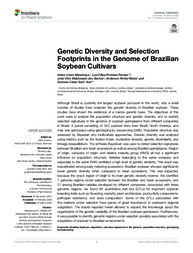Genetic diversity and selection footprints in the genome of brazilian soybean cultivars.
Genetic diversity and selection footprints in the genome of brazilian soybean cultivars.
Author(s): MENDONÇA, H. C.; PEREIRA, L. F. P.; SANTOS, J. V. M. dos; MEDA, A. R.; SANT?ANA, G. C.
Summary: Although Brazil is currently the largest soybean producer in the world, only a small number of studies have analyzed the genetic diversity of Brazilian soybean. These studies have shown the existence of a narrow genetic base. The objectives of this work were to analyze the population structure and genetic diversity, and to identify selection signatures in the genome of soybean germplasms from different companies in Brazil. A panel consisting of 343 soybean lines from Brazil, North America, and Asia was genotyped using genotyping by sequencing (GBS). Population structure was assessed by Bayesian and multivariate approaches. Genetic diversity was analyzed using metrics such as the fixation index, nucleotide diversity, genetic dissimilarity, and linkage disequilibrium. The software BayeScan was used to detect selection signatures between Brazilian and Asian accessions as well as among Brazilian germplasms. Region of origin, company of origin, and relative maturity group (RMG) all had a significant influence on population structure. Varieties belonging to the same company and especially to the same RMG exhibited a high level of genetic similarity. This result was exacerbated among early maturing accessions. Brazilian soybean showed significantly lower genetic diversity when compared to Asian accessions. This was expected, because the crop?s region of origin is its main genetic diversity reserve. We identified 7 genomic regions under selection between the Brazilian and Asian accessions, and 27 among Brazilian varieties developed by different companies. Associated with these genomic regions, we found 96 quantitative trait loci (QTLs) for important soybean breeding traits such as flowering, maturity, plant architecture, productivity components, pathogen resistance, and seed composition. Some of the QTLs associated with the markers under selection have genes of great importance to soybean?s regional adaptation. The results reported herein allowed to expand the knowledge about the organization of the genetic variability of the Brazilian soybean germplasm. Furthermore, it was possible to identify genomic regions under selection possibly associated with the adaptation of soybean to Brazilian environments.
Publication year: 2022
Types of publication: Journal article
Unit: Embrapa Coffee
Keywords: Genetic variance, Genome, Soybeans
Observation
Some of Embrapa's publications are published as ePub files. To read them, use or download one of the following free software options to your computer or mobile device. Android: Google Play Books; IOS: iBooks; Windows and Linux: Calibre.
Access other publications
Access the Agricultural Research Database (BDPA) to consult Embrapa's full library collection and records.
Visit Embrapa Bookstore to purchase books and other publications sold by Embrapa.

